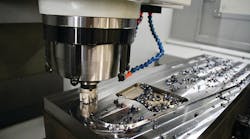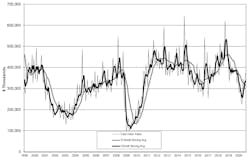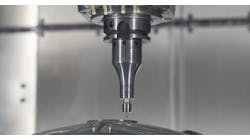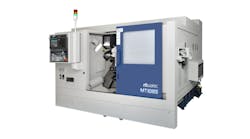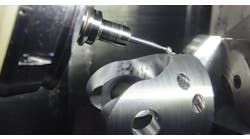U.S. machine shops and other manufacturers purchased $373.7 million worth of machine tools during September, +26.4% more than the August total, the highest monthly purchase value to date for the current year, as well as the highest monthly unit count at 2,354 metal-cutting and metal-forming/fabricating machines.
However, the September result is -3.2% lower than the September 2019 total and brings the nine-month total value for 2020 “manufacturing technology” orders to $2.32 billion, -24.3% lower than the January-September 2019 order. The results are provided by the AMT – the Assn. for Manufacturing Technology in its monthly U.S. Manufacturing Technology Orders report.
The USMTO is a forward-looking index to manufacturing activity, tracking manufacturers’ capital investments in anticipation of future work orders. It contains actual figures for new orders of metal-cutting and metal-forming and -fabricating equipment, nationwide and in six geographic sectors, based on information supplied by participating producers and distributors of that equipment.“In addition to the positive numbers this month, we are now seeing the economic recovery reach a broader spectrum of the overall capital equipment market,” stated AMT president Douglas K. Woods, president of AMT.
The weakness in new equipment orders is multifaceted: Machine tool demand slowed throughout the second half of 2019, due to slackening industrial activity, and it was forecast by AMT to rebound in late 2020. However, the Covid-19 pandemic brought all industrial activity to a halt followed by sporadic restarting, and now each sector of the manufacturing technology market continues to combat the underlying weakness while aiming to recover according to varying sectoral and regional opportunities.
Woods continued: “Manufacturing is ramping back up as production, shipments, and order levels continue to improve throughout most sectors. The high demand for mold-and-die products during the height of the pandemic led to reshoring portions of the industry’s output. Additionally, a strong housing market continues to expand demand for household appliances, creating backlogs that will keep production lines busy into the winter.”
Woods noted however that there are “soft spots” remaining in the manufacturing supply chain, citing the aerospace and oil-and-gas sectors – which he pointed out represent almost one-third of manufacturing orders – “(that) will likely need several years to return to pre-Covid levels of shipments and capital spending.”
Regionally, the increases in new orders for metal-cutting equipment were concentrated in the North Central-West (+55.5% from August; -9.3% compared to September 2019) and South Central (+44.7% from August; -6.4% from September 2019.)
Elsewhere, the decrease in orders for metal-cutting machinery was most profound in the North Central-East (-48.3% / -24.6%), though the Northeast (-13.8% / -54.2%), Southeast (-7.7% / -8.4%), and West (-6.8% / -11.8%) also posted decreased demand.
“Unlike the recovery from the great recession, this recovery will not impact manufacturing sectors equally,” Woods observed. “Material handling, mold and die, and firearms will have a better year in 2020 than 2019. Manufacturing technology, cutting tools, and industrial machinery will return to 2019 levels sometime next year, but some key sectors will not see growth until after 2021.”
